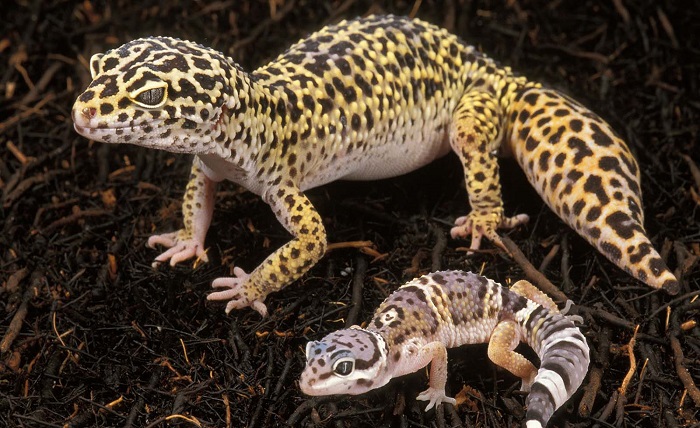Leopard Gecko Cute: The Ultimate Guide to These Adorable Reptiles

If you are looking for a pet that is both adorable and simple to care for, the leopard gecko is your best option. These small reptiles are popular among pet owners due to their adorable appearance, calm temperament, and low maintenance needs. This article will examine leopard geckos in detail, including their physical characteristics, habitat requirements, diet, and behavior.
What exactly are leopard gecko species?
Small, ground-dwelling leopard geckos are native to the deserts of Afghanistan, Pakistan, and portions of India. Their markings and patterns resemble those of a leopard, from which they derive their name. The average length of these reptiles is between 6 and 10 inches, and they appear in a variety of colors, including yellow, orange, brown, and white.
Characteristics of Leopard Geckos
One of the characteristics that make leopard geckos so adorable is their distinct appearance. This species of reptile has a round cranium, large eyes with vertical pupils, and a small, triangular tail. Their bodies are covered in smooth, soft skin, and they have short, stocky legs with sharp talons for climbing and gripping surfaces.
Habitat Requirements for Leopard Geckos
Because leopard geckos inhabit hot, arid environments in the wild, it is essential to establish a similar habitat for them in captivity. This includes supplying a terrarium or tank with a lid that prevents escape that is at least 10 gallons in size. The enclosure should be lined with a substrate, such as sand or coconut fiber, that replicates their natural habitat. It is also essential to provide geckos with places to hide, such as rocks or artificial caves when they desire privacy.
Diet of Leopard Geckos
Carnivorous leopard geckos primarily consume insects such as crickets, mealworms, and waxworms. It is essential to offer your gecko a varied diet and to gut-load insects before serving them to your pet. This involves feeding the insects a nutrient-rich diet so the gecko can profit from the nutrients when it consumes the insects. In addition, it is necessary to sprinkle the insects with a calcium supplement to prevent nutritional deficiencies.
The conduct of Leopard Geckos
Leopard geckos are known for their docile nature and make excellent pets for novices or those seeking a low-maintenance animal. They are nocturnal and spend the majority of the day concealed in their enclosure. However, they are active at night and will venture out to hunt or investigate their environment. Leopard geckos are solitary creatures that must be confined individually because they can become aggressive with one another.
Common Health Issues in Leopard Geckos
While leopard geckos are generally healthy pets, they can suffer from a variety of health issues if not properly cared for. Some of the most common health problems include shedding difficulties, metabolic bone disease, and digestive issues. It is important to monitor your gecko’s health and behavior and to seek veterinary care if you notice any signs of illness.
Tips for Caring for Leopard Geckos
Caring for leopard geckos requires some basic knowledge and attention to detail. Here are some tips to help ensure that your pet remains healthy and happy:
- Provide a suitable enclosure with appropriate temperature and lighting
- Offer a varied diet of gut-loaded insects and calcium supplements
- Provide hiding spots for privacy and reduce stress
- Monitor your gecko’s health and behavior regularly
- Avoid handling your gecko too much, as they can become stressed and aggressive
Conclusion
Leopard geckos are undeniably cute and make Leopard geckos are undeniably cute and make great pets for those looking for a low-maintenance and gentle pet. As long as they are provided with suitable habitat, a varied diet, and proper care, they can live for up to 20 years in captivity. If you are considering getting a leopard gecko, be sure to do your research and provide the best care possible for your new pet.
FAQs
Do leopard geckos make excellent pets for children?
Children can have leopard geckos as pets if they are supervised and taught how to handle them appropriately. They are typically docile and simple to care for, making them an excellent option for beginners.
How often should my leopard gecko be fed?
Every other day, leopard geckos should be served a varied diet of insects and calcium supplements.
Can leopard geckos be kept in groups?
No, leopard geckos are reclusive creatures that must be kept alone to prevent aggression and stress.
How can I determine if my leopard gecko is ill?
Appetite loss, lethargy, incontinence, and difficulty shedding are all symptoms of illness in leopard geckos. If you observe any of these symptoms, you should seek veterinary care immediately.
Do leopard geckos need UVB lighting?
Although leopard geckos do not require UVB illumination, it can be advantageous to their health and well-being. If you decide to provide UVB lighting, do so for no more than 12 hours per day and provide a basking area where the gecko can escape the UVB radiation if it so chooses.





